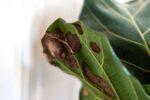Ficus Lyrata (Fiddle Leaf Fig) Brown Leaves, Leaves Falling Off
We have just recently moved in to our first home so knew it was possible for our Fiddle Leaf Fig to drop some leaves. A lot of my leaves have brown spots on the edges. (I do live in Colorado, we are super dry) but I’m concerned about the last few leaves that have dropped. They are always on the bottom of the plant. The veins of the plants are very light and yellow almost, and rest of the leaf is not a deep dark green. I just need to figure this out. If I’m under watering or over watering. Thanks so much for your time.
Hi Jacqueline,

There are several things that could be causing a Fiddle Leaf Fig to get ugly brown marks on its leaves and for Leaves to fall off.
Improper Watering (esp. over watering): A Fiddle Leaf Fig (Ficus Lyrata), requires less water than other ficus trees. Allow the top 50% of the soil to dry out and the leaves to become soft and flexible before watering. Once the soil has dried out, water well until the water comes out the drip holes in the bottom of the pot. Do not allow the plant to sit in water. When plants are over-watered, older leaves and those at the bottom of the stems turn brown and fall off. To make things really confusing, when the plant does not get enough water, the new leaves turn brown and fall off. From the way the roots are bulging, I’d say it was over watered.
Cold temperatures: A Fiddle Leaf Fig does well in temperatures between 60°-80°F (15.5°-26.7°C). Keep all ficus plants away from air conditioners, drafts, and heating vents.
Fertilizer: Fertilize a Fiddle Leaf Fig monthly in the spring and summer using a basic houseplant food diluted to 1/2 the recommended strength. Too much fertilizer when the plant is not actively growing causes leaf burn (brown leaf edges). Do not feed during the fall and winter.
Light: A Fiddle Leaf Fig requires bright indirect light. Insufficient light causes small new growth and leaf drop. Turn the plant frequently to keep it growing straight upwards and not leaning towards the light. Too much sun causes the leaves to fade and lose their dark green color.
You can read all my care tips for a Fiddle Leaf Fig in the Popular Houseplant section of the website.
https://www.houseplant411.com/houseplant/ficus-lyrata-how-to-grow-care
These plants are considered poisonous and should be kept away from pets and children. The sap of a Fiddle Leaf Fig plant is very irritating so use gloves when working with this plant. Read more about common houseplants that are poisonous in my book Don’t Feed Me To Your Cat! A Guide to Poisonous Houseplants.
